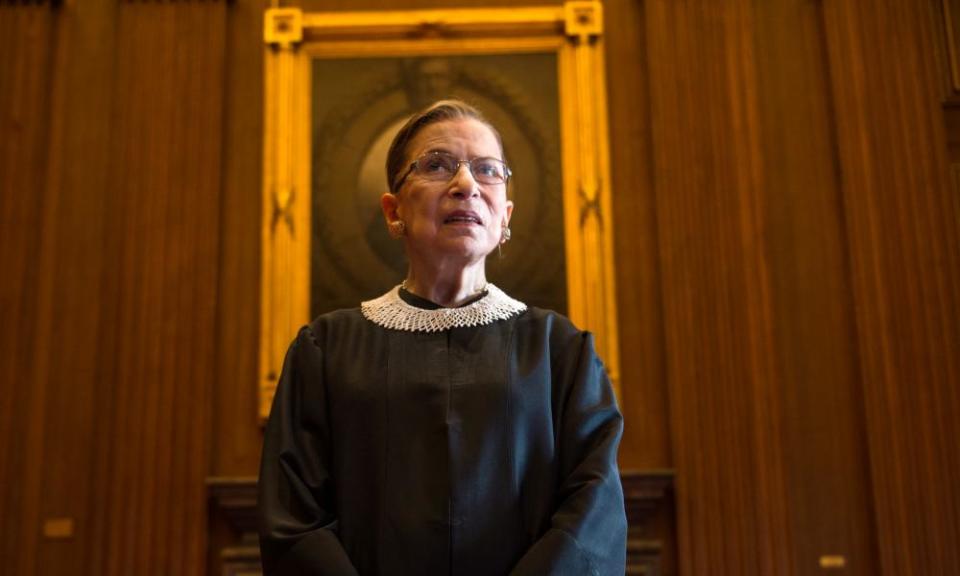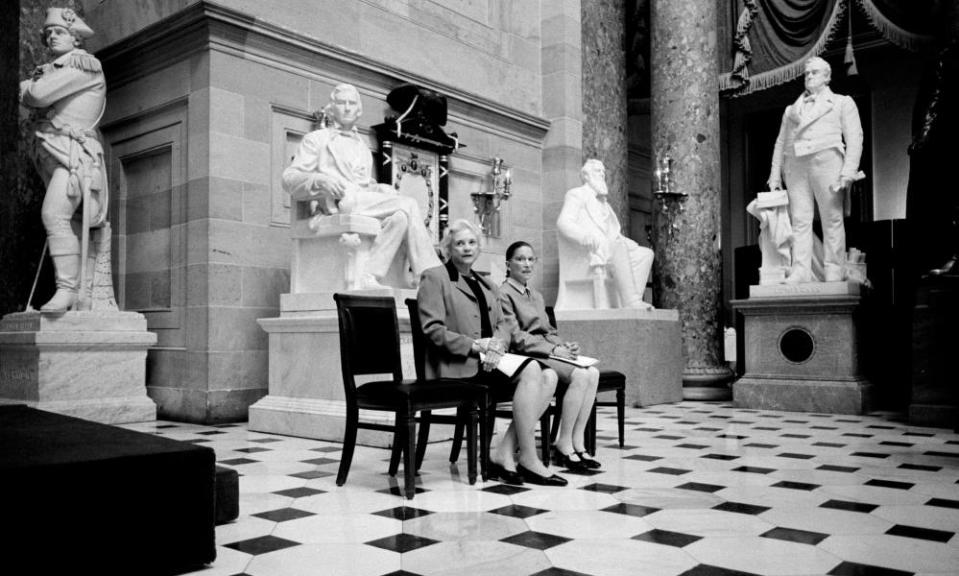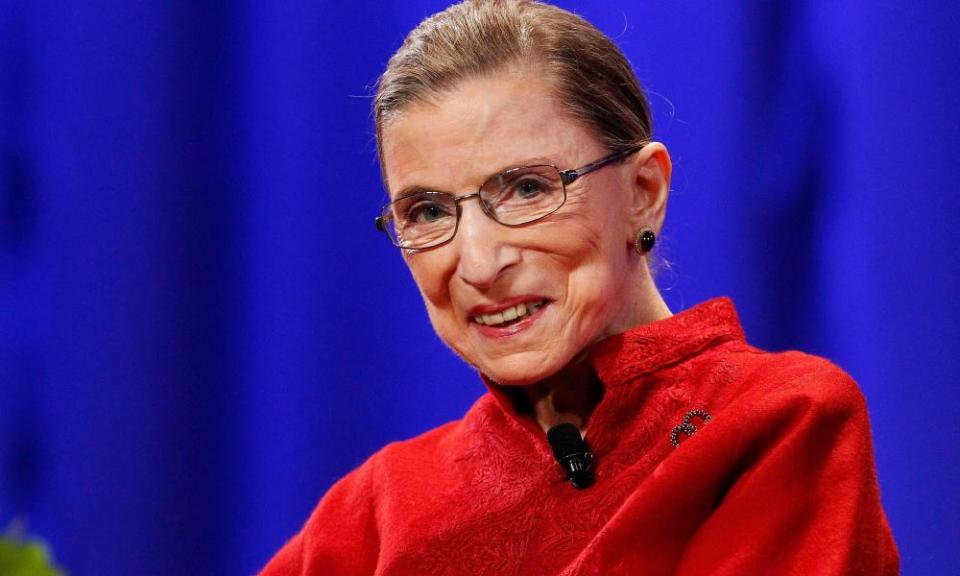Ruth Bader Ginsburg changed America long before she joined the supreme court

The most important feminist lawyer in the history of the American republic has died. Ruth Bader Ginsburg, a supreme court justice and singularly influential legal mind, was appointed by Bill Clinton in 1993, the court’s second-ever female justice, and served for nearly 30 years. She passed away due to complications from cancer on Friday. She was 87.
Strategic, contemplative and disciplined, but with a passion for the feminist cause that is rarely admitted into the halls of power, Ginsburg established an impressive legal legacy long before she became a judge. Over the course of a two-decade career as a lawyer before her appointment to the DC circuit court of appeals, she successfully argued cases that expanded civil rights law and 14th amendment protections to women, undoing a dense network of laws that had codified sex discrimination in all areas of American life. After she was elevated to the nation’s highest court, she found her own views moving left as the institution was pushed to the right. Her career was defined by courageous dissents that stood up for the principle of equal justice and kept alive the promise of a more free and fair America.
Born in Flatbush, Brooklyn, in 1933 to Jewish parents, Ginsburg showed early signs of curiosity and defiance. Her childhood nickname was “Kicky”, because as a baby she flailed her legs. Her mother, Celia, was her confidante and a fierce advocate for Ruth’s education. Celia, the daughter of Austrian immigrants, had a tremendous intellect but worked in a garment factory because her education had been cut short. She dreamed her daughter would be able to graduate college and become a high school history teacher.

Celia died of cancer when Ginsburg was just 17, after a short life of hard work and deflated hopes. The gap between her mother’s potential and opportunities haunted Ruth. This may have been a catalyst for the singular focus of Ginsburg’s legal career: she spent the rest of her life working to make sure that intelligent women like her mother would no longer be held back from their full potential on account of their sex.
It wasn’t easy. After graduating Cornell, the shy Ginsburg married an outgoing and ambitious man named Marty, and gave birth to their daughter, Jill, at 23. The couple both enrolled at Harvard Law School, where Ginsburg, then the parent of a toddler, nevertheless managed to become a leader of the law review. Harvard law had only recently begun admitting women: there were nine women in her class, compared to 500 men. At one point, the contemptuous dean gathered the female law students, including Ginsburg, made them stand in front of him, and asked them each how they justified taking a place at the law school that could have been filled by a man. Later, after she had graduated, one of her professors recommended her for a clerkship with the supreme court justice Felix Frankfurter. Frankfurter declined: he wasn’t “ready” to hire a woman.
Ginsburg is the rare supreme court justice whose most significant work was done before she joined the court
It would not be the last time that Ginsburg lost a job due to her sex. These kinds of sexist rejections were not only common, they were completely legal. That they are not legal anymore is due largely to Ginsburg’s own work. Through a series of strategic and brilliantly argued cases that she brought before the courts as a lawyer, she dragged the law into recognizing women’s rights by the sheer force of her intellect and will.
Ginsburg is the rare supreme court justice whose most significant work was done before she joined the court. She changed the course of American law not as a supreme court justice, but as a lawyer, the founder and general counsel of the ACLU’s Women’s Rights Project. Ginsburg began the project in 1972, the same year she joined the faculty of Columbia Law as a professor; by 1974, the project had participated in nearly 300 gender discrimination cases nationwide. Ginsburg personally argued six gender discrimination cases before the then all-male supreme court, winning five. She built on her victories one by one, establishing precedents that made future victories easier to win.

First was Reed v Reed (1971), a monumental victory that struck down an Idaho law favoring men over women in estate battles. That case extended the Equal Protection Clause of the 14th amendment to women, barring laws that discriminated by sex. Ginsburg followed this case with victories in Frontiero v Richardson (1973), barring gender discrimination in compensation of military members, and Weinberger v Wiesenfeld (1975), striking down gender discrimination in state benefits. Her tactics were savvy; she framed gender discrimination in ways that made the practice seem unreasonable even to hardened misogynists. In Craig v Boren, she successfully convinced the court that state laws that distinguished on the basis of sex needed to be subjected to at least what was called “intermediate” scrutiny; she won the decision not by arguing for women to have equal freedom to men, but equal obligations. In Weinberger, she managed to get a discriminatory practice deemed illegal largely by virtue of finding a rare case in which the victim of sex discrimination was a man.
These victories, coming down between the years 1971 and 1976, forced laws to change nationwide. It is impossible to overstate their impact. One moment, much of family, tax, and financial law was made of statutes that codified men as breadwinners and beneficiaries, women as dependents. Within just five years, all these laws were declared unconstitutional. At the time the supreme court first ruled in Ginsburg’s favor, in Reed v Reed in 1971, many banks still would not issue women credit cards. By the end of it, her work had helped to usher in a feminist revolution that has changed the face of American families and expanded the possibilities for American women’s lives.
Ginsburg has frequently been compared to Thurgood Marshall, the great supreme court justice and African American civil rights jurist. It is a comparison that she reportedly disliked – with typical modesty, she felt it gave her too much credit, and was quick to emphasize that, unlike the Black jurist, she had never felt that her safety was under serious threat. But there is something to the comparison between their careers, particularly the extent to which they focused on using the law to open opportunities for the marginalized. Both took the 14th amendment seriously, perhaps more seriously even than the people who wrote it. Ginsburg and Marshall saw vast swaths of the American people who had been excluded from the American promise, and they spent their careers forcing the law to recognize those people’s humanity and dignity.
There is also another way that Ginsburg was like Marshall: during their times on the court, both found themselves consistently in the minority, writing dissents more often than majority opinions. As a liberal on a conservative court, one which only grew more conservative during her decades of service, Ginsburg was not as influential during her later career as she might have been had she had more progressive colleagues. She became famous for her dissents, often fiery statements of principle that the conservative majority did not share. With notable exceptions, her presence on the supreme court was less a full use of her talents and more of a check against the wildly conservative and at times even revisionist views of the rightwing justices. Her vote served less to shape the law than to check her colleagues’ worst impulses.

Perhaps this safeguarding role on the court is why, over the last decade or so of her life, Ginsburg was elevated into a status that academics and legal experts rarely attain: pop culture icon. She was nicknamed the Notorious RBG, in honor of her fellow Brooklyn iconoclast, the rapper Biggie Smalls. Her early legal career inspired a 2018 film, On the Basis of Sex, starring Felicity Jones, an English actress who shares Ginsburg’s toothy smile but could not quite master her Brooklyn accent. You could buy her image on tote bags and enamel pins on Etsy. Her face, complete with big glasses, a low bun, and her famous studded collars, became a kind of metonym for a dream of women’s equality, a dream that seemed doomed to be dashed.
She is survived, too, by the women whose lives and careers she made possible through her legal work
There was a palpable anxiety underlying this idol worship of Ginsburg. As women’s rights became increasingly imperiled and conservative judges were added to lifetime appointments at all levels of the federal judiciary, the rollback of civil rights for women transformed from a possibility to a dark inevitability. Abortion became inaccessible in large parts of the country, banned in practice where not banned in law; the gains she made to nondiscrimination law were eroded by religious exemptions and bad-faith intellectual contortions made by judges more interested in ensuring a conservative outcome than upholding the law. In the later years, she seemed to be holding on to life with sheer force of will, determined to remain alive to vote in favor of civil rights and to not to allow Donald Trump to fill her seat. But even years before, as she advanced into her 80s, nervous jokes began to be made about her longevity. A viral video was made about her fitness routine; people tried not to think too hard about the fact that she had been in and out of cancer treatments since 1999. In one cheeky instance, her face was printed on birthday cards: “Happy Birthday,” the cards read, beneath a print of her in her judicial robes. “I hope you live forever.” Of course, she couldn’t.
Now Ruth Bader Ginsburg is dead. But there is reason to believe that the dream of women’s equality under the law will not die with her. She is survived by her daughter, Jill, herself a law professor, and by the generation of female law students and clerks whom she mentored, younger legal minds who will carry on her legacy. She is survived, too, by the women whose lives and careers she made possible through her legal work. When Ginsburg’s mother, Celia Bader, died in 1950, she had lived an unfairly constrained life that did not match her capabilities. She did not dream that her daughter would achieve the heights that she did, influencing the course of American law and opening new opportunities for generations of American women. In interviews, Ginsburg spoke of her family’s ascent as typical of the American dream: there was only one generation between the mother, the factory worker, and the daughter, the supreme court justice. This was always the hope of America, that this sort of ascent would be possible. Ginsburg made it possible for women.
Moira Donegan is a Guardian US columnist

 Yahoo News
Yahoo News 